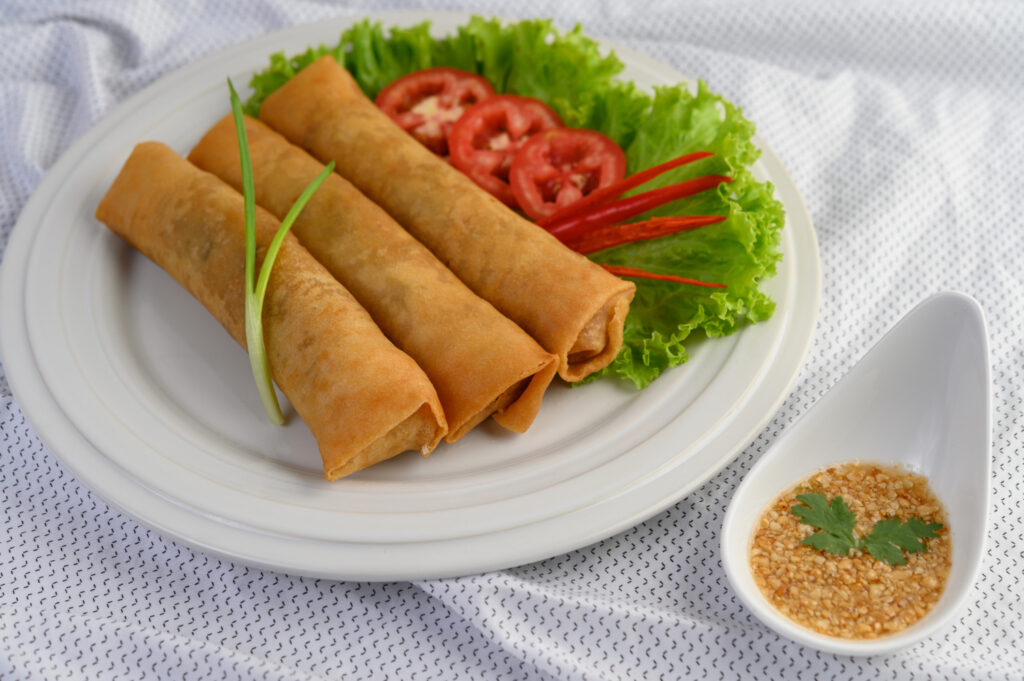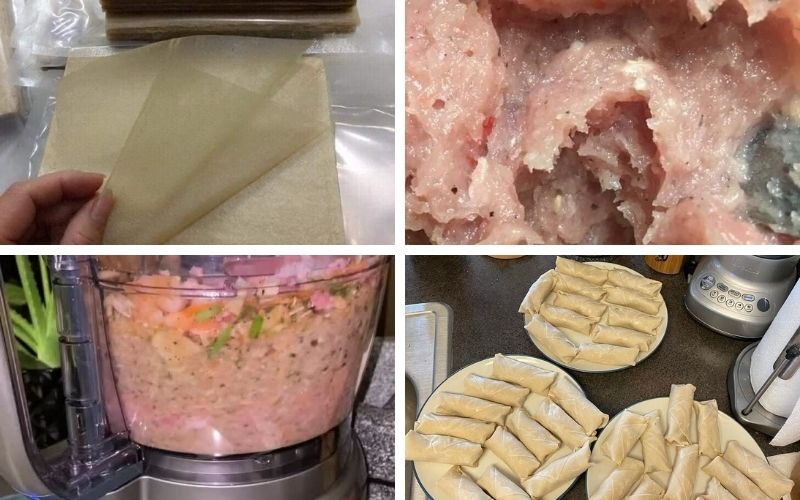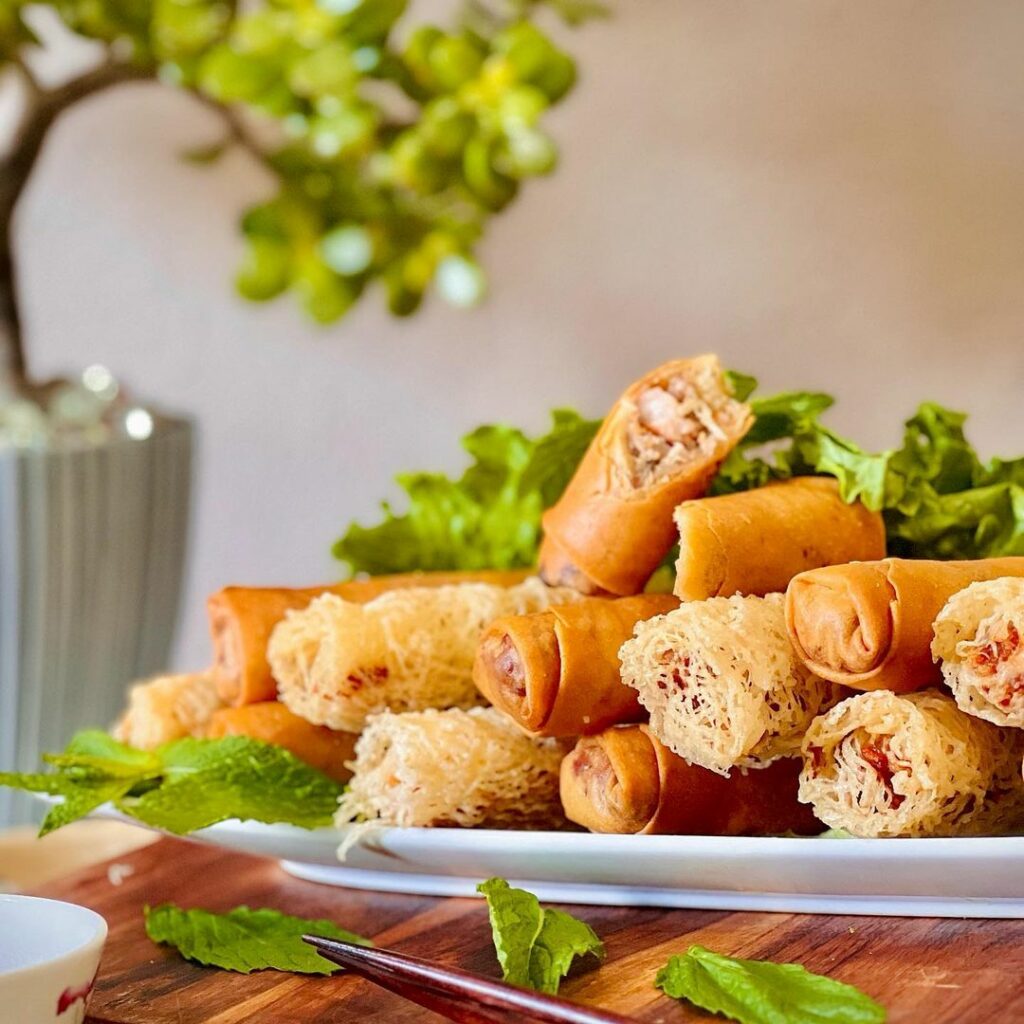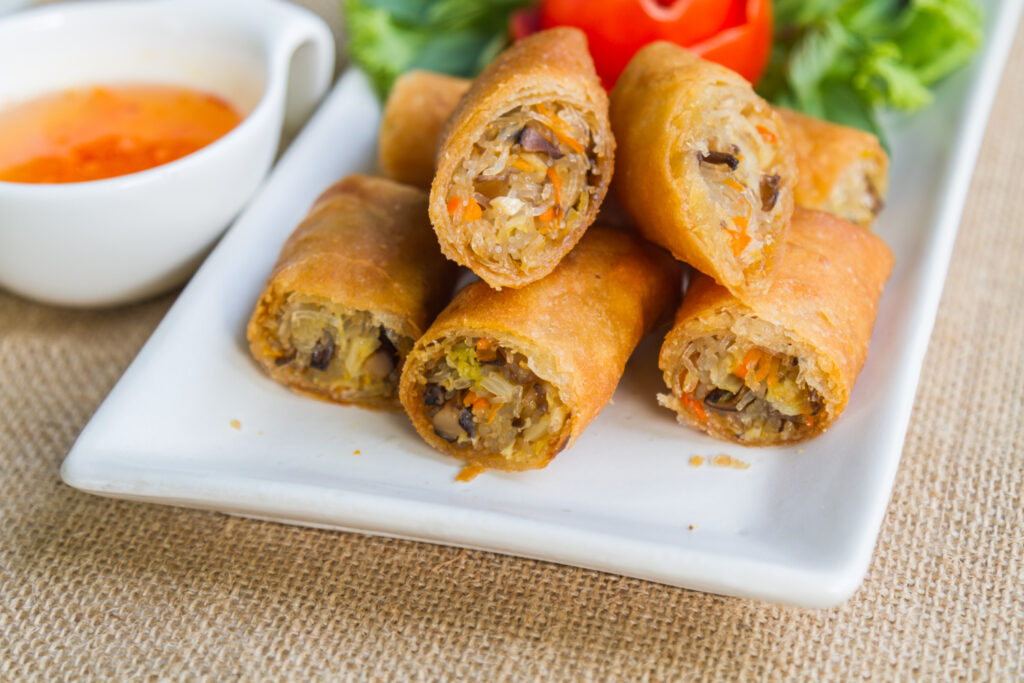Vietnamese egg rolls are one of my favorite dishes from my travels to Vietnam. The crispy texture and flavorful filling always satisfy my cravings. In this article, I’ll share my personal experience and guide you through making your own delicious and authentic Vietnamese egg rolls at home.
From the history and ingredients to rolling techniques and cooking methods, this comprehensive guide will help you recreate the flavors of Vietnam in your kitchen. Get ready to indulge in this tasty and popular Vietnamese dish!
But first, you need to distinguish the difference between spring roll vs egg roll.
What are Vietnamese egg rolls?

Vietnamese egg rolls, or cha gio Vietnamese egg rolls, are a type of deep-fried roll filled with ground pork, vegetables, and various seasonings. The origin of Vietnamese egg rolls can be traced back to the imperial courts of Vietnam. They were once a delicacy reserved for the ruling class, but have since become popular street food enjoyed by people from all walks of life.
There are also regional variations of Vietnamese egg rolls, with different fillings and cooking methods used in different parts of Vietnam.
For example, in the northern region of Vietnam, the filling is typically made with ground pork, carrots, cellophane noodles, and wood ear mushrooms, while in the southern region, shrimp and taro are often used as ingredients. Despite these variations, the crispy texture and savory flavor remain a defining characteristic of Vietnamese egg rolls.
What are popular Vietnamese egg roll recipes?
There are many popular Vietnamese egg roll recipes, ranging from traditional to modern variations. Here are a few examples:
- Traditional Vietnamese egg rolls
- Vegetarian Vietnamese egg rolls
- Seafood Vietnamese egg rolls
- Fusion Vietnamese egg rolls
Tips for modifying Vietnamese egg roll recipes to your taste include adjusting the amount of seasoning, using different types of meat or vegetables, or experimenting with different dipping sauces. With a little creativity, the possibilities are endless!
Vietnamese egg roll recipe

Vietnamese egg roll recipe it’s important to make sure the oil is hot enough (around 350-375°F) before adding the egg rolls to ensure they cook evenly and become crispy.
Cooking note
- Yield: 15-20 egg rolls
- Prep time: 30 minutes
- Cook time: 15-20 minutes
- Total time: 45-50 minutes
- Course: Appetizer
- Cuisine: Vietnamese
- Equipment: Deep-fryer or large pot, slotted spoon, mixing bowl
Ingredients
- 15-20 Vietnamese rice paper wrappers
- 1 pound ground pork
- 2 cups shredded carrots
- 2 cups shredded cabbage
- 1/2 cup chopped onions
- 2 cloves garlic, minced
- 1 teaspoon salt
- 1 teaspoon black pepper
- 2 tablespoons fish sauce
- 1 tablespoon sugar
- 1 quart vegetable oil for frying
How to make Vietnamese egg rolls?
Making Vietnamese egg rolls may seem daunting, but with the right preparation and cooking methods, it’s actually quite simple. If you can make cha gio Vietnamese, will you ask “how to wrap Vietnamese egg rolls“, I will show you how to roll beautiful and attractive cha gio Vietnamese. Here’s a step-by-step guide:
Filling
- In a mixing bowl, combine the ground pork, shredded carrots, shredded cabbage, chopped onions, minced garlic, salt, black pepper, fish sauce, and sugar.
- Mix well until fully combined.
Preparation
- To wrap Vietnamese egg rolls, start by soaking a rice paper wrapper in warm water until it’s pliable.
- Lay the wrapper on a flat surface and add the filling in a straight line, leaving space at the edges.
- Fold the sides of the wrapper towards the center, then roll the wrapper tightly from the bottom to the top.
- Repeat with the remaining wrappers and filling.
Cooking
- Vietnamese egg rolls are typically deep-fried in hot oil until they’re golden brown and crispy.
- Alternatively, they can be air-fried for a healthier option. To deep-fry, heat vegetable oil in a deep-fryer or large pot until it reaches 350-375°F.
- Carefully add the egg rolls to the hot oil and cook for 5-7 minutes, or until they’re crispy and fully cooked.
- To air-fry, brush the egg rolls with oil and cook at 375°F for 10-12 minutes, flipping halfway through.
Dipping sauce
Mix together 1/4 cup fish sauce, 1/4 cup rice vinegar, 1/4 cup water, 1/4 cup sugar, 1 minced garlic clove, and 1 diced Thai chili pepper.
With these simple techniques and tips, you can make delicious and authentic Vietnamese egg rolls at home. How to wrap Vietnamese egg rolls is a key step in the process, so be sure to follow the instructions carefully for the best results.
What are common mistakes when making Vietnamese egg rolls?

While making Vietnamese egg rolls can be a fun and rewarding experience, there are a few common mistakes that can easily be avoided with the right techniques and tips:
- Overfilling the wrappers: It’s important not to overfill the rice paper wrappers, as this can cause them to tear or break during frying. Stick to a small amount of filling, and leave space at the edges to ensure the wrappers can be sealed properly.
- Undercooking or overcooking: It’s crucial to cook the egg rolls for the right amount of time to ensure they’re crispy on the outside and fully cooked on the inside. Undercooking can result in raw meat, while overcooking can cause the egg rolls to become burnt or tough.
- Not using the right oil temperature: If the oil isn’t hot enough, the egg rolls may become soggy or greasy. On the other hand, if the oil is too hot, the egg rolls may cook too quickly and burn. It’s important to maintain a consistent temperature of around 350-375°F.
- Using the wrong type of wrapper: Vietnamese egg rolls are typically made with rice paper wrappers, which are thin and pliable. Using the wrong type of wrapper can result in a different texture and taste.
- Not draining the egg rolls properly: After frying, it’s important to drain the egg rolls on a paper towel or wire rack to remove any excess oil. Failing to do so can result in greasy and unappetizing egg rolls.
Tips and tricks to make Vietnamese egg rolls
Making perfect Vietnamese egg rolls takes some practice, but with these tips and tricks, you can elevate your egg roll game and impress your guests!
Tips for storing and reheating Vietnamese egg rolls:
- To store leftover egg rolls, place them in an airtight container and refrigerate for up to 3 days.
- To reheat, preheat your oven to 350°F and place the egg rolls on a baking sheet. Bake for 10–15 minutes, or until heated through and crispy.
Tricks for making perfect Vietnamese egg rolls
- Use a mixture of ground pork and shrimp for a more flavorful filling.
- Add shredded taro or sweet potato to the filling for a unique twist.
- Brush the egg rolls with a beaten egg before frying them to create a shiny, golden-brown exterior.
- Fry the egg rolls in small batches to ensure they cook evenly and become crispy.
- Experiment with different dipping sauces, such as peanut sauce or sweet chili sauce, to find your perfect pairing.
How many calories are in a Vietnamese egg roll?
Vietnamese egg rolls are a delicious and popular dish, but they are not necessarily the healthiest option due to their deep-fried preparation. Here’s a breakdown of the nutritional value of Vietnamese egg rolls:
| Nutrient | Amount per serving (1 egg roll) |
| Calories | 190 |
| Total fat | 9g |
| Saturated fat | 2g |
| Cholesterol | 25 mg |
| Sodium | 25 mg |
| Carbohydrates | 19g |
| Dietary fiber | 1g |
| Sugars | 1g |
| Protein | 7g |
While Vietnamese egg rolls do provide some protein and fiber, they are also relatively high in calories, fat, and sodium. It’s important to enjoy them in moderation and pair them with healthier options like a side salad or steamed vegetables. Additionally, opting for air-fried Vietnamese egg rolls instead of deep-fried can help reduce the calorie and fat content.
So, are Vietnamese egg rolls healthy? While they can be enjoyed as part of a balanced diet, they should be eaten in moderation and paired with other nutritious foods to create a well-rounded meal.
Variation of Vietnamese egg rolls
Vietnamese egg rolls are a versatile dish that can be made with a variety of fillings and flavors. Here are some popular variations of Vietnamese egg rolls:
- Vegetarian egg rolls Vietnamese: Made with shredded vegetables like carrots, cabbage, and mushrooms, along with cellophane noodles and various seasonings.
- Seafood Vietnamese egg rolls: Made with shrimp, crab, or other seafood, along with vegetables and seasonings like garlic, ginger, and soy sauce.
- Chicken Vietnamese egg rolls: Made with ground chicken, along with vegetables and seasonings like lemongrass, garlic, and cilantro.
- Tofu Vietnamese egg rolls: Made with crumbled tofu, along with vegetables and seasonings like garlic, ginger, and soy sauce.
- Fusion Vietnamese egg rolls: These egg rolls are made with a unique twist, such as adding cheese, avocado, or other non-traditional ingredients to the filling.
These variations offer a range of flavors and options for different dietary preferences. Whether you prefer classic pork and vegetable filling or a more unique fusion twist, there’s a Vietnamese egg roll variation for everyone to enjoy.
How to eat Vietnamese egg rolls?

Vietnamese egg rolls can be enjoyed in a variety of ways, depending on personal preferences. Here are a few tips on how to eat Vietnamese egg rolls:
- Dip in sauce: Vietnamese egg rolls are typically served with a sweet and savory dipping sauce made with ingredients like fish sauce, sugar, and vinegar. Dip the egg rolls into the sauce before taking a bite for a burst of flavor.
- Pair with herbs: Vietnamese egg rolls are often served with a variety of fresh herbs like cilantro, mint, and Thai basil. Add some herbs to the top of the egg roll before taking a bite for a refreshing burst of flavor.
- Eat as a main dish or appetizer: Vietnamese egg rolls can be served as a main dish or as an appetizer. Enjoy them on their own as a light meal, or pair them with rice and other dishes to create a more substantial meal.
What to serve with Vietnamese egg rolls?
- Rice: Vietnamese egg rolls can be paired with steamed rice to create a more filling meal.
- Salad: A side salad can help balance out the flavors of the egg rolls and provide some extra vegetables.
Vietnamese egg rolls are a versatile and delicious dish that can be enjoyed in a variety of ways. Whether served as a Vietnamese snack main dish or appetizer, paired with rice or salad, or dipped in sauce and herbs, they are sure to satisfy your cravings for savory and crispy flavors.
Substitute ingredients Vietnamese egg rolls
If you’re looking to make Vietnamese egg rolls but need to substitute certain ingredients, there are a few options that can work well:
- Meat substitutes: If you’re vegetarian or vegan, you can substitute the ground pork in Vietnamese egg rolls with crumbled tofu, tempeh, or textured vegetable protein (TVP). These alternatives can be flavored with the same seasonings and sauces as the original recipe.
- Gluten-free wrappers: Traditional Vietnamese egg roll wrappers are made with rice flour, which is naturally gluten-free. However, some brands may add wheat flour to their wrappers, so be sure to check the label. If you need a gluten-free option, look for wrappers made with 100% rice flour or try using lettuce leaves as a wrapper instead.
- Different vegetables: While cabbage and carrots are traditional vegetables used in Vietnamese egg rolls, you can experiment with different vegetables based on your preferences or what you have on hand. Shredded zucchini, sweet potato, or kale can work well as substitutes.
- Sauce substitutes: If you’re unable to find traditional Vietnamese dipping sauce ingredients like fish sauce or rice vinegar, you can try making a simple sauce with soy sauce, honey, and lime juice instead. This can provide a similar sweet and savory flavor profile.
FAQs
Do Vietnamese egg rolls have gluten?
Traditional Vietnamese egg rolls are made with rice paper wrappers, which are naturally gluten-free. However, some brands may add wheat flour to their wrappers, so it’s important to check the label to ensure they are gluten-free.
Can Vietnamese egg rolls be made ahead of time?
Yes, Vietnamese egg rolls can be made ahead of time and stored in the refrigerator or freezer until ready to cook. To store in the refrigerator, place them in an airtight container and refrigerate for up to 3 days.
To store in the freezer, place them on a baking sheet and freeze until solid, then transfer them to a freezer bag or container and freeze for up to 2 months.
What’s the difference between Vietnamese egg rolls and Chinese egg rolls?
While both Vietnamese egg rolls and Chinese egg rolls are deep-fried and have a crispy exterior, there are some key differences between the two.
- Vietnamese egg rolls typically use rice paper wrappers and are filled with a mixture of ground pork, vegetables, and cellophane noodles. They also typically have a sweet and savory dipping sauce made with fish sauce, sugar, and vinegar.
- Chinese egg rolls, on the other hand, are typically made with wheat flour wrappers and are filled with a mixture of cabbage, carrots, and meat. They may be served with a variety of dipping sauces depending on the region.
What dipping sauce goes well with Vietnamese egg rolls?
A traditional sweet and savory dipping sauce made with fish sauce, sugar, and vinegar pairs well with Vietnamese egg rolls.
You can also try a peanut sauce or sweet chili sauce for a different flavor profile.
How do you prevent Vietnamese egg rolls from falling apart during frying?
To prevent Vietnamese egg rolls from falling apart during frying, make sure the wrapper is moist but not too wet. Don’t overfill the wrapper and be sure to wrap it tightly.
Use a mixture of cornstarch and water to seal the edges of the wrapper before frying. Additionally, make sure the oil is hot enough before adding the egg rolls, as this will help them cook evenly and hold their shape.
How do you know when Vietnamese egg rolls are fully cooked?
Vietnamese egg rolls are fully cooked when they turn golden brown and crispy on the outside. To ensure they are fully cooked, fry them for 3-4 minutes per side or until they reach an internal temperature of 165°F.
Can you make Vietnamese egg rolls with quinoa?
While quinoa is not a traditional ingredient in Vietnamese egg rolls, you can certainly experiment with using it as a filling if you prefer. Just be sure to flavor the quinoa with seasonings and sauces that complement the other flavors in the egg roll.
What is the best brand of rice paper for Vietnamese egg rolls?
There are several brands of rice paper that work well for Vietnamese egg rolls. Some popular options include Three Ladies, Banh Tran Dau Xanh Duc Binh, Banh Trang Dai Nam. It’s important to choose a high-quality brand that won’t easily tear or become too brittle when fried.
You may need to experiment with different brands to find the one that works best for you and your recipe. Additionally, be sure to follow the instructions on the package for soaking and handling the rice paper to ensure the best results.
Conclusion
With this in mind, Vietnamese egg rolls are a delicious and versatile dish that can be enjoyed in a variety of ways. With the right ingredients, rolling techniques, and cooking methods, you can create your own authentic and flavorful egg rolls at home.
Whether you prefer traditional fillings or more unique variations, this dish is sure to satisfy your cravings. So why not give it a try and experience the authentic flavors of Vietnamese cuisine? We hope this guide has provided you with the knowledge and inspiration to create your own mouth-watering Vietnamese egg rolls.